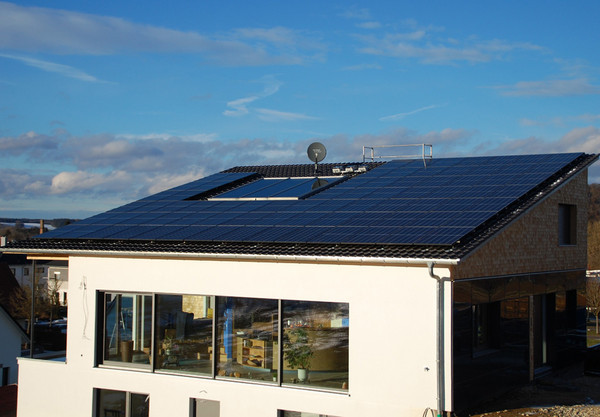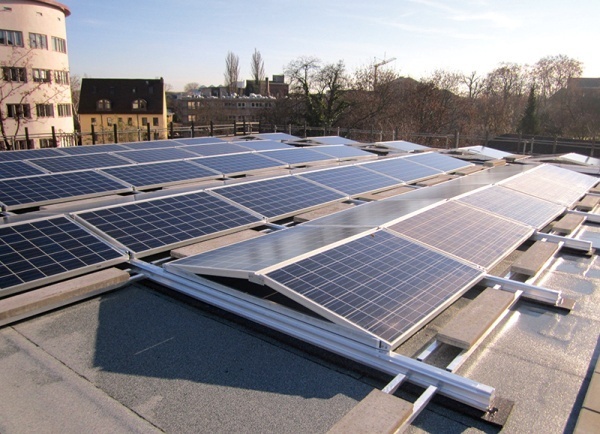 |
Hanwha Q Cells officials check the quality of solar cells. (Hanwha Q Cells) |
Market turbulence brought on by the pandemic has left many companies in shambles. Some forward-looking corporations took the unease as an opportunity to reset and refocus, in order to emerge stronger in the post-pandemic era.
For Hanwha Solutions, this was a prime time to invest.
Aiming to dominate the global solar-to-hydrogen business, the Hanwha Group company announced last month a plan to raise 1.2 trillion won ($1.09 billion) through rights offering.
The new share issue is part of the company’s grand plan to inject 2.8 trillion won in its solar power and hydrogen businesses over the next five years to lead the next energy revolution for “green hydrogen.”
“When Hanwha Solutions secures hydrogen electrolysis technology and combines that with its world-leading solar cell technology, the company will rise as the most powerful green hydrogen producer,” said Hyundai Motor Securities analyst Kang Dong-jin.
Green hydrogen
Despite its eco-friendly image, around 95 percent of all hydrogen in the world is generated by fossil fuels such as natural gas and coal, which defeats the very purpose of using hydrogen, according to the International Renewable Energy Agency.
To replace carbon-intensive hydrogen, the so-called “green hydrogen” has recently emerged as a viable option.
Green hydrogen is produced by a chemical process called electrolysis, which uses electric current to break water into hydrogen and oxygen. If this electricity is generated by renewable energy sources such as solar and wind, the hydrogen is labeled green hydrogen.
Hanwha Solutions plans to inject half of the 1.2 trillion won investment into creating a green hydrogen ecosystem, as the global hydrogen market, which stood at $786.9 million in 2019, is projected to reach $2.28 billion by 2027, according to Grand View Research.
Hanwha Solutions was formed by a merger of three different companies in January last year -- Hanwha Q Cells, Hanwha General Chemical and Hanwha Advanced Materials.
And for a green hydrogen ecosystem, the three make a perfect team.
Q Cells, the No.6 solar panel manufacturer in the world by shipment as of 2019, can generate clean electricity using its own solar panels and energy storage systems. With that energy, General Chemical can produce hydrogen using its electrolysis technology. Then, Advanced Materials can contribute to the production of storage tanks for the hydrogen produced.
According to Hanwha Solutions, 400 billion won will be put into the development of next-generation solar cells, while 200 billion won will be spent for the production, storage and retail of hydrogen.
However, Hanwha Solutions’ ambitious plan has a key hurdle to clear: price competitiveness.
The hurdle
 |
Hanwha Q Cells’ rooftop solar panels in Augsburg, Germany (Hanwha Q Cells) |
According to the International Energy Agency, green hydrogen production costs $3 to $7.5 per kilogram, while hydrogen generated by natural gas costs $0.9 to $3.2 per kilogram.
Simply put, the fate of green hydrogen business hinges entirely on its price competitiveness.
Industry experts say that Hanwha Solutions is prepared to address this issue by ramping up the efficiency of its solar panels.
“How cheap solar panels can generate electricity is a key factor that determines the price of green hydrogen. Let’s say a solar panel can generate electricity at 100 won per kilowatt-hour. If a (more efficient) solar panel can generate electricity at 50 won per kilowatt-hour, it will cut the price of green hydrogen in half,” said Hyundai Motor Securities analyst Kang Dong-jin.
This is exactly why Hanwha Solutions is pouring 400 billion won to develop next-generation solar cells including N-type cells, perovskite cells and tandem cells.
“Hanwha Solutions is expected to commercialize N-type solar cells within two to three years. Then, it will take another two to three years to develop tandem cells, which are a hybrid of conventional solar cells and perovskite solar cells,” said Daishin Securities analyst Han Sang-won.
The N-type, perovskite and tandem solar cells, which exhibit much greater efficiency than conventional solar cells, are likely to play a key role in Hanwha Solutions’ green hydrogen ecosystem.
Depending on the type of chemical materials they are coated with, silicon-based solar cells are categorized into either N-type or P-type.
N-type solar cells, though more expensive due to an additional manufacturing process in higher temperature, demonstrates lifespan five times greater than P-type solar cells. Also, N-type solar cells can structurally offer higher efficiency rates than P-type solar cells, according to eBEST Investment & Securities analyst Anna Lee.
As of the first half of last year, there were seven solar modules with efficiency rates higher than 20 percent. The top five used N-type solar cells, according to Clean Energy Reviews.
If N-type solar cells are an advancement of conventional silicon-based solar cells, perovskite solar cells could be a game changer.
Perovskites are easily synthesized compounds with an orthorhombic crystal structure. Perovskite solar cells exploit micrometer-thin films made of these materials to harvest light.
Though 100 times to 200 times thinner than silicon-based solar cells, they can absorb the same amount of sunlight, making them light and flexible. In terms of the manufacturing process, silicon-based solar cells require higher temperatures -- above 1,000 degrees Celsius -- while perovskite solar cells can be manufactured at between 150 and 200 degrees Celsius, which translates into a significant cut in manufacturing costs.
When a layer of perovskite is placed on top of a silicon solar cell, it becomes a tandem solar cell. While perovskite solar cells absorb a shorter wavelength of blue light, silicon-based ones absorb a longer wavelength of red light. This difference in absorption depth allows tandem cells to maximize its efficiency rate.
“In theory, silicon-based solar cells’ maximum efficiency rate is 29 percent. However, tandem cells can achieve up to 44 percent,” a Hanwha Q Cells official said.
Fundamental change
 |
Hanwha Q Cells’ solar power modules installed in Frankfurt, Germany (Hanwha Q Cells) |
On top of developing next-generation solar cells, Hanwha Solutions aims to spend the other half of 1.2-trillion-won investment to diversify its business model to go beyond its current role as a supplier.
According to the company, it will spend 300 billion won for the acquisition and development of renewable power projects and the other 300 billion won for a dispersed energy resources business.
“It is positive that Hanwha Solutions is not just using the money to seek an expansion of size, but to improve its business model and pursue a structural change,” analyst Han said.
The first business model resembles that of construction companies. According to DB Financial Investment, Hanwha Solutions last year acquired solar power projects worth 2 gigawatts at 250 billion won. After completion, which will take between one and three years, the company will sell off those solar farms at 700 billion won to 800 billion won per gigawatt.
Hanwha is set to acquire a total 34 gigawatts of projects by 2025 and sell off 15.9 gigawatts of solar farms once they are completed. The revenue from the business is expected to record 700 billion won this year and climb to 4.4 trillion won by 2025.
Simultaneously, Hanwha Solutions is pursuing a dispersed energy resource business, or DER business, as the global DER market is projected to register an exponential growth up to 380 gigawatts by 2025 from the current 65 gigawatts, according to Hyundai Motor Securities.
Simply put, a DER business means operating small-scale power generation sources such as solar panels mounted on the rooftops of residential homes and selling the electricity to customers.
In August, Hanwha Solutions acquired a 100 percent stake in US-based energy software company Growing Energy Labs to expand into virtual power plant and retail solar power generation businesses.
“In response to global campaigns such as Renewable Energy 100, there is a growing demand from European companies to source electricity independently. As the price of solar panels and batteries is getting lower and lower, Hanwha Solutions can consider installing solar panels integrated with energy storage systems for those companies for free and charge electricity bills,” analyst Kang said.
Perfect market condition Making an investment is all about timing. In this sense, Hanwha Solutions couldn’t have chosen a better opportunity to make the 1.2-trillion-won investment.
As part of his Green New Deal initiative, US President Joe Biden aims to roll out 500 million solar panels across the nation by 2035.
Hanwha Solutions is the operator of the largest solar panel factory in the US that can churn out 1.7 gigawatts of solar panels a year, enough to power 600,000 households.
Above all, Biden’s ambitious plan is expected to further consolidate Hanwha Solutions’ dominant standing in the US market, as the country recently repealed tariff exemption on solar panels imported from China.
In the US, all imported solar panels have been subjected to tariffs since 2018. However, bifacial solar panels, designed to generate electricity from both sides, had been exempt from this tariff since 2019.
Using this loophole, bifacial solar panels imported from China infiltrated and eventually flooded the US market, accounting for 30 percent of total 5 gigawatts of solar panels installed in the country last year, according to Hyundai Motor Securities.
However, to keep Chinese products in check, the US repealed the tariff exemption on imported bifacial solar panels in November. This year, Chinese solar panels are subject to a penalty of 15 percent.
Hanwha Solutions is likely to become one of the greatest beneficiaries from the regulatory change. In the first half of last year, the company topped both US residential and commercial solar panel markets, commanding 22 percent and 21.5 percent of each of the markets respectively, according to Wood Mackenzie.
By Kim Byung-wook (
kbw@heraldcorp.com)










